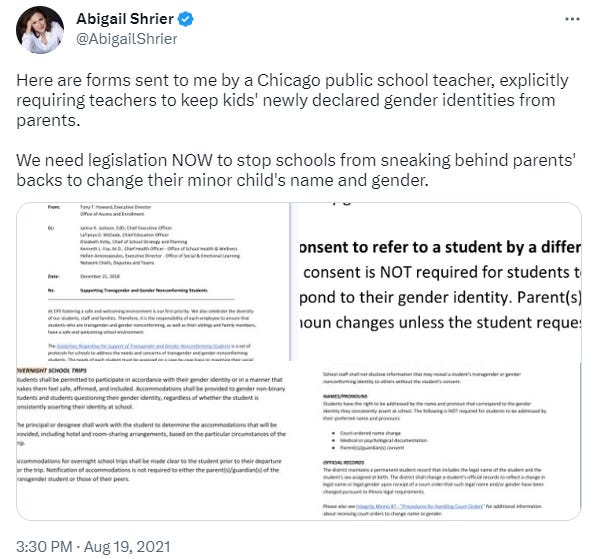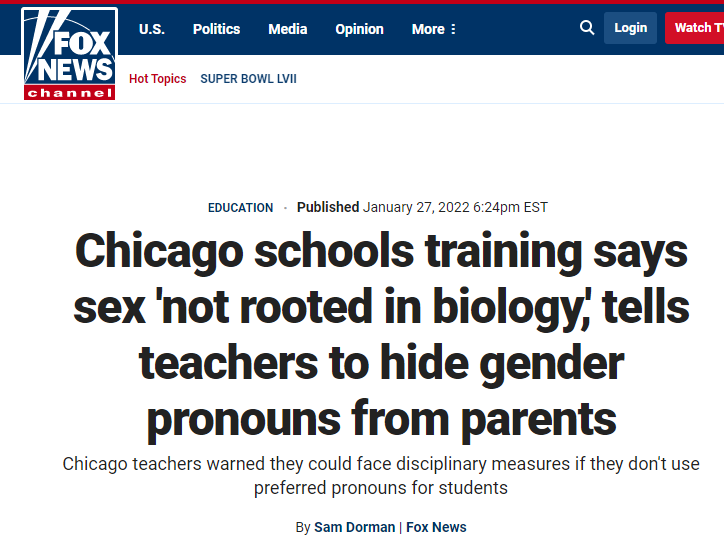Unfortunately, many public school districts have been overtaken by activist teachers who are deeply interested in dismantling the concept of gender and are profoundly anxious to talk about it with their students. And now we have hit a point in which harmful, incorrect notions of gender are embedded into professional development and curriculum. Dissenters have three choices: stomach it and deal with it on an hourly basis in order to keep your paycheck, stay and keep speaking out against it, or leave.
Originally Published by Pitt through Substack

I have a pretty comfortable teaching career. I’m leaving it at the end of this year.
As the sole breadwinner for my household, I’ve been blessed to have an income that hit the six-digits for the first time ever last year. I live near the school where I work—a rarity for most urban dwellers. My schedule and course load are really manageable and I have great benefits.
After attempts to move the needle in my school district regarding gender ideology, I’ve concluded that I no longer have a clear conscience about working in a setting in which this issue affects me on an hourly (not daily – hourly) basis. And based on the publication that you’re reading this in, you can probably guess why.
I would like to welcome you to my school’s teachers’ lounge, webinars, and faculty meetings to give you an idea of why our schools are becoming manufacturing plants producing dozens of trans-identifying kids. I will also share a few things I attempted to do to change things, the fact that I failed, and why I have to leave.
I remember a teacher meeting in 2015 in which a young arts instructor sitting next to me said to everyone that we should have all students introduce themselves with their pronouns and found that to be an odd way of advocating for the inclusion of the handful of students we had who might identify as a different gender.

Things kept evolving and, for awhile I thought it was mostly a new development among our young people. But then I saw information coming down the pipeline from the school district and eventually started to learn that my school district wasn’t going to just foster acceptance and tolerance—it was actually going to become a disseminator of the new ideology.
In late 2018, I opened my inbox to find an “integrity memo” stating that parental consent is not required to refer to students by a different name, pronoun, or gender. Accommodations for overnight trips were to be made “in accordance with their gender identity”, and that “notification of accommodations is not required to either the parent(s)/guardian(s) of the transgender student or those of their peers.” That seemed egregious. I passed this onto Abigail Shrier who then posted it on Twitter. I figured that this would bring some much-needed bad publicity to my school district and possibly pressure them to change their policies.

A couple years later, my school district released an online module all employees in the district had to complete. I was shocked to hear the presenter – an employee of the school district’s central office – assert that “the concepts of gender and sex are actually not rooted in biology… Instead, they are socially constructed, which means they have been created and enforced by people in a society.” I rolled my eyes as I watched and listened to this webinar, which was longer than the combined durations of the webinars about chronic conditions and being a mandated reporter.
Listening to that webinar wasn’t the end. A group of activist teachers at my school, led by a teacher who identifies as trans-femme, found the information to be so incredibly valuable that they believed it was important for us to turn around and teach it to the students. They took a lot of content from that webinar and developed it into a mini-presentation for students that they sent out for all of us to present during the homeroom/advisory hour.
In a faculty meeting set aside to prepare us to present it to students, one teacher-presenter insisted that “this is doctrine” according to our state and the school district, while chopping his hand in a Bible-thumping, Southern Baptist preacher motion.
The trans-femme teacher says that students who offer different pronouns – such as, “I go by she/they” – need to be referred to by both sets of pronouns, and that we need to mix them up, or they will notice. This teacher also stated that she sends out a Google form once a month for students to indicate if their name, gender, or pronouns have changed. Another teacher (who uses they/them pronouns) said that one of their students wears a color-coded bracelet to indicate which pronouns they will be using that day.
Another teacher chimed in and suggested that the newly designated gender-neutral bathroom should have the urinals removed from it to make it feel like a more gender-neutral space. Dozens of heads around the room nodded in agreement. My head was thinking about how little they understand about the cost of construction and plumbing.
Having to teach this to students was when I knew trouble was really brewing for me. Affirming my students’ alternative names that they choose primarily from Greek mythology and outer space, and affirming their alternative genders on an hourly basis was problematic enough. Concealing student info from parents violated my conscience enough. But now I had to teach the ideology itself to students. I knew that the social studies teacher down the hall taught his students that the concept of binary gender was a western colonialist imposition, but that was not something I was willing to do.
Because I had a good relationship with my assistant principal and our HR manager, I was able to negotiate myself out of presenting a lot of content in that presentation, and the day of the presentation came and went. A few days later, an email with a strange request hit our inboxes. One of the teacher presenters asked us to provide a post gender presentation survey link to our students in which two questions were asked. The first question was, “Was the gender presentation given in your advisory?” The second was, “Was the information given accurate?”

I scratched my head. Why would they ask teachers to pass along a survey to students asking the students to indicate that I did my job in presenting the content, and then ask the students if the content was accurate? If a student marked that the information presented was inaccurate, who does that reflect on? If I had opted to not present the content, would I have even shared that survey with students? Did word spread through the grapevine that I didn’t say everything I was supposed to say, and they were on to me?
At this point, I felt compelled to do more anonymous whistleblowing. I reached out to LibsofTikTok with the content of my district’s long webinar about supporting gender non-conforming students. She felt that it deserved a bigger audience (yes, bigger than LibsofTikTok) and hooked me up with FoxNews, who interviewed me and published this article in January 2022.

Surely this would bring more pressure onto the district, I thought. Surely this will generate some much needed heat. Even Lara Trump quoted my statement from the article on an evening program. A candidate for governor in my state posted the article and said that if elected, he would be doing something about these matters. Look at all the waves I’m making!

In September 2022, there were some updates to the online professional development session. My district stated that “children who assert a gender-diverse identity know their gender as clearly and consistently as their peers” (emphasis is not mine – it’s theirs). I shared it with LibsofTikTok, who then posted it to Twitter, and tagged my school district on it. Now those folks at the central office will really be feeling it, I thought.
Nothing changed. Absolutely nothing. The mean Twitter comments, the phone calls from media outlets, and the questions all just get thrown into the “hate mail” pile never to be seen. Whereas other school districts have heated town hall meetings about these policies and curriculum, my district is just too large to care about one anonymous whistleblower and too large to have school board meetings where the public can show up and express opposition. Third graders will continue to share their pronouns and learn about binary and nonbinary genders the first week of class, and kindergarten girls will continue finding themselves in the bathroom with random fifth-grade boys. Yes, both of those things are happening.
One day I was messaging back and forth with an old high school classmate about these district policies, particularly about the mandate to conceal a child’s name, gender, and pronouns from parents if requested. She has a transgender identifying child herself. She finds our district policies pretty appalling, and she typed “What are you going to do?” That really hit me. A friend of mine with a trans-identifying child finds much of this to be really off-base and was asking me what I was going to do—the presumption being, I had to do something other than keep plowing away. And the best conclusion I came to was that I must leave.
Being a public school teacher used to be one of the most innocent career paths that one could choose. The job description of a teacher doesn’t include using sly tactics like a used car salesman, making fake promises like a political candidate, or pollution of the environment like a manufacturing plant. You learn a subject, learn how to teach it, be firm and friendly with students, coach a sport and inspire your students to keep discovering.
Unfortunately, many public school districts have been overtaken by activist teachers who are deeply interested in dismantling the concept of gender and are profoundly anxious to talk about it with their students. And now we have hit a point in which harmful, incorrect notions of gender are embedded into professional development and curriculum. Dissenters have three choices: stomach it and deal with it on an hourly basis in order to keep your paycheck, stay and keep speaking out against it, or leave.
Parents will have to confront these same three choices as well. My choice is to leave. And on my way out the door and beyond, I intend to make as many parents as possible aware of what is happening so that they can make a well-informed educational decision for their children. What will your decision be?
Times have clearly changed—but now, from the outside, I am going to do my best to blow the whistle and restore sanity to my once honorable profession.

